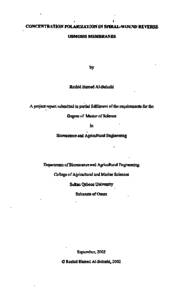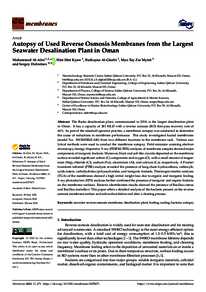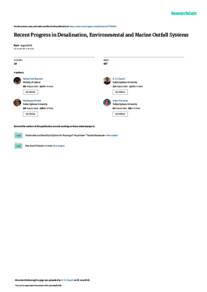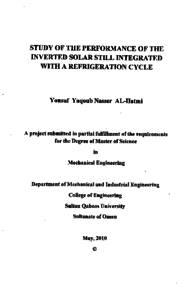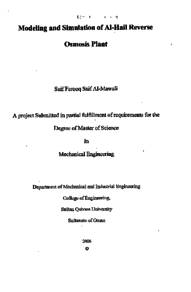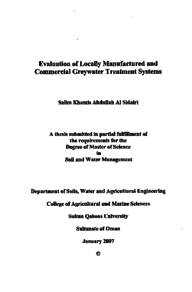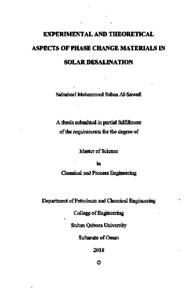Document
Concentration polarization in spiral-wound reverse osmosis membranes
Publisher
Sultan Qaboos University
Gregorian
2002
Language
English
English abstract
Membrane life time and permeate fluxes are primarily affected by the phenomena of concentration polarization (i.e. accumulation of solute) and fouling (i.e. microbial adhesion, gel layer formation and solute adhesion) at the membrane surface. A primary reason of flux decline during the initial period of a membrane separation process is concentration polarization of solute at the membrane surface. The main objective of the present study was to analyze and model concentration polarization in spiral wound membrane elements. In particular the influence of feed pressure, solute concentration, flow rate, temperature and spacer thickness in the membrane units on permeate flow and its salinity was evaluated. A laboratory. scale reverse osmosis unit, equipped with spiral wound seawater reverse Osmosis module was used to conduct the experiments. Our studies showed that the permeate flux increased with increasing feed/transmembrane pressure at a given feed solute concentration. The permeate flux also decreased considerably at higher feed solute concentration (i.e. feed salinity) suggesting the build up of a higher level of solute (i.e. concentration polarization) at the membrane surface. When the feed flow rate was decreased from 18 to 9 L/h, at constant temperature, the permeate flux decreased, but only at the higher feed pressures and higher salt concentrations. This suggested that the polarization of solute at the membrane surface was reduced at higher feed flow rates.
A major finding of our work was that the polymer membrane is very sensitive to changes in the feed temperature. There was up to a 60 % increase in the permeate flux when the feed temperature was increased from 20 to 40°C. This occurred both in the presence and absence of solute. Surprisingly, the permeate flux appears to go through a minimum at an intermediate temperature. There was up to a 100 % difference in the permeate flux between feed temperatures of 30 and 40°C. The differences were statistically significant (p<0.05). The temperature seemed to influence the membrane permeability hence the quality and quantity of the permeate. The effects of spacer thickness on permeate flux suggest that the observed flux decreases by up to 50% in going from a spacer thickness of 0.1168 to 0.0508 cm. The different geometry/configuration of the spacer may influence turbulence at the membrane surface that in turn affected concentration polarization. This suggests less turbulence with the smaller spacer thickness. The membrane module with an intermediate spacer thickness of 0.0711 cm was found to be the best economically since it gave the highest water production rate (L/hr). Membrane parameters were also estimated using an analytical osmotic pressure model (i.e. the combined film theory/Spiegler-Kedem model). The modeling studies showed that the membrane transport parameters were mainly influenced by the feed salt concentration and temperature
Description
Thesis
Member of
Resource URL
Arabic abstract
يتأثر عمر الغشاء وكذلك كمية المياه العذبة المتدفقة بشكل رئيسي بظاهرة الاستقطاب التركيزي تراكم المادة المذابة أي الأملاح والانسداد والترسب (التصاق الميكروبات وظهور مواد هلامية ملتصقة مع المادة المذابة على سطح الغشاء. وكان الهدف الأساسي لهذا المشروع تحليل ومحاكاة الاستقطاب التركيزي للأغشية الحلزونية . وتركزت الدراسة بشكل جزئي على معرفة تأثير عوامل ضغط الماء المغذي وتركيز المادة المذابة ومعدل التدفق ودرجة الحرارة وسمك الفلكة المباعدة في وحدة الغشاء على كمية المياه العذبة المتدفقة من الغشاء وتركيز ملوحتها. اعد لعمل هذه الدراسة باستخدام وحدة التناضح العكسي - في مختبر هندسة الموارد الحيوية والزراعية المجهزة و المتصلة بغشاء حلزوني مصمم لتصفية مياه البحر. أوضحت الدراسة أن كمية المياه العذبة المتدفقة النافذة ارتفعت بازدياد ضغط المياه المغذية على تراكيز محددة للمادة المذابة، وتناقصت كمية المياه العذبة المتدفقة النافذة بشكل كبير مع ازدياد تراكيز الملوحة للمادة المذابة منها. وبالتالي زيادة تراكم مستوى المادة المذابة (الاستقطاب التركيزي على سطح الغشاء. وعندما يتناقص معدل كمية المياه المتدفقة من 18 لتر/ ساعة إلى 9 لتر / ساعة مع تثبیت درجة الحرارة تناقصت المياه العذبة المتدفقة النافذة مع زيادة ضغط المياه المغذية الداخلة وتركيز ملوحتها، لذلك فان الاستقطاب التركيزي للمادة المذابة يتناقص مع زيادة معدل التدفق . وقد استخلصت هذه الدراسة أن غشاء البوليمرهو غشاء حساس يتأثر بتغير درجة الحرارة المياه المغذية الداخلة، حيث كان هنالك زيادة كبيرة للمياه العذبة المتدفقة النافذة بحوالي 60 % عندما ازدادت درجة الحرارة للمياه المغذية من 20 إلى 40 درجة مئوية و التي رافقت غياب المادة المذابة. ويعود السبب في ذلك إلى هبوط درجة لزوجة الماء عند ازدیاد درجة حرارتها مما يصغر جزيئات الماء و يسهل مرورها خلال الغشاء، واللافت للنظر في هذه الدراسة أن كمية المياه العذبة المتدفقة قد أظهرت تناقصا عند درجة الحرارة المتوسطة (30 درجة مئوية) بمعدل 100 % بين كمية المياه العذبة المتدفقة من 30 إلى 40 ° مئوية على الرغم من الاختلافات في النتائج تعتبر ذات دلالة ومعنى حيث أن الاحتمالية أقل من. 05 كما أن درجة الحرارة تشير إلى تأثير نفاذية الغشاء بخصائصه الفيزيائية وبالتالي التأثير على نوعية وكمية المياه المصفاة النافذة . أما بالنسبة لتأثير سمك الفلكة المباعدة تبين أن المياه العذبة المتدفقة النافذة تناقصت إلى النصف بداية مع الفلكة المباعدة ذات سمك 0 . 1168 سم إلي . 0508 سم ، ويؤثر الاختلاف في الشكل والتصنيع للفلكة المباعدة على سطح الغشاء وبالتالي على الاستقطاب التركيزي. يقترح من خلال هذه الدراسة أن تصنيع الغشاء ذو الفلكة المباعدة الصغيرة يقلل من الاضطراب داخل الغشاء كما أوضحت هذه الدراسة أن الغشاء ذو الفلكة المباعدة المتوسطة (. 0711 سم) هو من أفضل الأغشية من الناحية الاقتصادية لأنه أعطى أكبر معدل من المياه العذبة المتدفقة (لتر/ ساعة) .ومن ناحية أخرى بينت الدراسة العملية لهذا المشروع أن متغيرات الغشاء استنتجت عن طريق استخدام صياغة الضغط الأسموزي التحليلي ( تجميع نظرية الغشاء و الصياغة التحليلية لسبيجلر کیدم)، ولقد تبين من الصياغة التحليلية لهذه الدراسة أن متغيرات انتقال الغشاء تتأثر بتركيز ملوحة المياه المغذية ودرجة الحرارة.
Category
Theses and Dissertations

